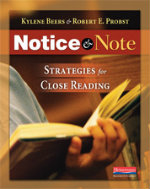Close Reading Strategies
Notice & Note: Strategies for Close Reading
By Kylene Beers and Robert Probst
(Heinemann, Nov. 15, 2012 Learn more)
Let me begin at the end. In the acknowledgements at the end of Notice & Note: Strategies for Close Reading, the authors pay homage to what I call Teacher Truth:
“You’ll try what’s in here; find ways to make the lessons better; change them so that they are uniquely ours. You’ll keep teaching through the foolishness that seems to be part of education these days. When people talk of measuring the “value added” by a teacher, we tell them we don’t need complicated math formulas. (silent cheer.) They only need to look at you -‐ you arrive early, stay late, celebrate your students’ successes, worry over those who need perhaps more than you can give, and always wonder what else you can do. We laugh at the thought that your value is measurable by a test score.”
Sold! Buy the book. Encore!
The book’s structure
Rigor. Interaction. These two words describe the strategies used in the real-life classroom situations related in this book by Kylene Beers and Robert E. Probst. Solid theory supporting practical application — that’s the foundation undergirding the six “signposts” the authors use to point the way to strengthen readers of all levels.
 What are these signposts? They are, in order of appearance:
What are these signposts? They are, in order of appearance:
- Contrasts and Contradictions
- Aha Moments
- Tough Questions
- Words of the Wiser
- Again and Again
- Memory Moment
Six lessons. Six signposts. Six anchor questions. One goal: to help teachers foster rigorous reading and high-level thinking. The book emphasizes three commonalities among those “signposts”: stand out features in text, generalizable language, and insightful comprehension.
Each of these signposts has a chapter with scripts from actual lessons in the classroom, called “Classroom Close – Ups,” complete with thought bubbles and highlighted noteworthy parts. This is a lovely feature for those of us who don’t have time to sit down for the whole show but want the highlights.
Reproducibles. Charts. Surveys. Text excerpts for teaching the signpost lessons. All found in the book itself: a complete cast waiting in the wings for you to bring them out when their part is needed and your audience is ready.
It’s the stuff you try to teach the kids every day
The six signposts identified by Beers and Probst are not unfamiliar concepts to most ELA and literacy teachers, but they are presented in a way that places them naturally and gradually in your classroom. These concepts aren’t on laminated posters lining your room. They are seated at your tables with your students. They are doodling questions on the page margins. They are putting their fists under their chins and asking your students to think. These strategies are not about you. They are about the students, and hopefully they’ll walk out the door in students’ pockets with their iPods. Then they can plug in whatever strategy they learned the next time they need it. Music to a teacher’s ears.
Beers and Probst made this point at the end of their book:
Much as we hope our students will have the experience of losing themselves in a book, at the same time we hope that they’ll have the experience of finding themselves in a book.”
Notice & Note: Strategies for Closed Reading shows readers effective strategies that will help them navigate and “noodle” as they read. That’s how the lost get found.
Sandy Wisneski is lead teacher at Catalyst Charter Middle School, which opened in the fall of 2012. She is the district webmaster, tech mentor, and yearbook advisor as well as a new teacher mentor. Over the past 37 years she has become certified as a Flat Classroom Teacher and obtained her masters in reading. She enjoys challenging students to “take ownership” for their learning and to be effective digital citizens in the world.


































